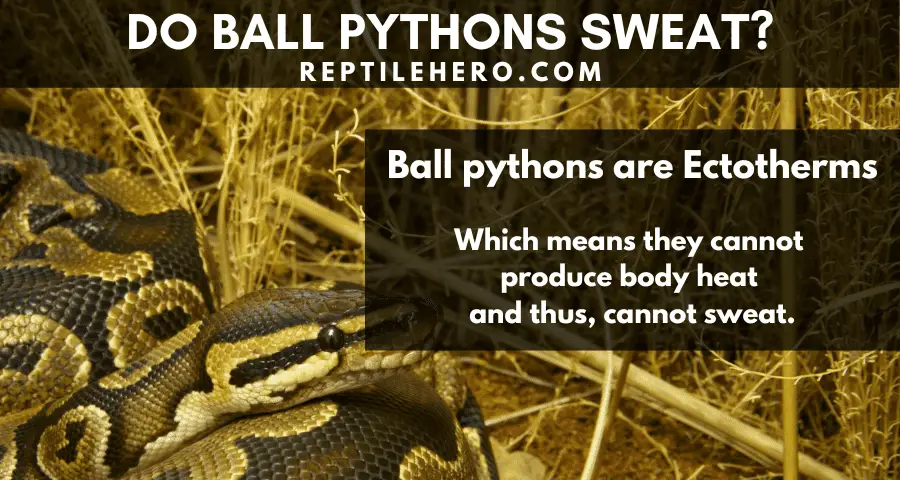When Ball Pythons Get Too Hot?
Why do ball pythons overheat? As a ball python owner, you are probably wondering what the highest temperature they can tolerate is. What will happen to them if temperatures get higher than usual? Will it be fatal?
A ball python is getting too hot if the ambient temperature goes above 95°F. An overheating ball python can exhibit symptoms like restlessness, lethargy, diarrhea, regurgitation, and neurological issues. High temperatures can also cause thermal burns to a ball python.
Ball pythons came from sub-Saharan Africa, where it’s typically hot and humid. What are the effects of high temperatures on them? What are things to do to lessen heat inside their enclosure? Find out more as you read below!
Highest Temperature For Ball Pythons
On average, the highest heat provided to a ball python in captivity is around 90-93°F or 32-34°C. In the wild, their burrows can get temperatures as high as 90°F and the ambient heat can get up to 95°F, especially during mid-day.
Ball pythons are ectotherms which means that they are cold-blooded animals that need external factors to regulate their body temperature. Because of this, they can overheat if they are unable to find cool shelter in a very hot environment.

Ball pythons that are provided with the optimal heat can digest their food well [1]. Proper temperature levels can also help in preventing respiratory diseases.
| Temperature (Fahrenheit) | Equivalent |
| Below 60 | High risk of respiratory infection (RI), can be fatal |
| 61-69 | Too cold, moderate risk of RI’s |
| 70-75 | Night time temperatures when breeding, low risk of RI’s |
| 78-82 | Cold side temperature |
| 83-88 | Recommended ambient temperature |
| 89-92 | Recommended hot side temperature |
| 95-99 | Too hot, can cause stress and overheating |
| 100 and above | Fatal, can cause burns |
For ball pythons, I recommend having temperature gradients from 80-90°F. With this range, the risks of RI’s and overheating will be minuscule.
2 Problems Caused by High Temperatures in Ball Pythons
Overall, ball pythons housed in an enclosure with temperatures exceeding 95°F for a long time can experience: 1) overheating, and 2) burns.
1. Overheating
Ball pythons that are constantly in temperatures 95°F and above have a high chance of being overheated. This can cause them a great amount of stress and can be fatal when left unnoticed for prolonged periods.
Overheating ball pythons typically exhibit the following symptoms:
- Restless movements
- Lethargy
- Diarrhea
- Regurgitation
- Neurological issues
>> Learn more about ball python diarrhea and other illnesses in our article does ball python poop smell?
If your ball python keeps on circling around its enclosure at a fast pace or looks very weak, then it may be getting overheated.
Some keepers have also observed that ball pythons that are accidentally exposed to temperatures of 100°F and over exhibit neurological issues. This includes stargazing, spinning, and shaking which are caused by brain damage due to high heat.
For overheating ball pythons that exhibit neurological issues, I suggest taking it to a veterinarian to gauge whether or not it is temporary or permanent damage.
2. Burns
In general, thermal burns in ball pythons are caused by heating devices that overheated or had direct contact with the snake. A ball python that has been burnt must be taken immediately to a veterinarian due to the risk of infection.
Thermal burns are commonly caused by unregulated heat devices, especially heat mats. Ball pythons tend to burrow to seek out the heat source which causes them to come in contact with a very hot part of the enclosure.
Burns from a ball python will heal after several sheds depending on the severity of the injury.
If you cannot immediately take your burnt ball python to a veterinarian, I suggest letting it soak in a betadine or povidone-iodine water solution for about 10-15 minutes. Then place the snake into a clean temporary enclosure with moist tissue sheets as its substrate.
3 Tips for Optimal Heat in a Ball Python Enclosure
There are a few ways to prevent excessive heat and control temperatures inside a ball python enclosure, namely: 1) thermostat, 2) thermal gradient, and 3) location.
1. Thermostat
For all heating devices used for ball pythons, it is recommended to use a thermostat. Otherwise, heaters may become too hot and cause overheating in snakes.
Not only does a thermostat prevent your heating devices from overheating, the majority of existing models can also measure the temperature and humidity of the enclosure.
>> Learn more about reptile thermostats in our article about choosing the right thermostats for geckos
Overall, there are 3 kinds of thermostats: 1) on/off, 2) pulse-proportional, and 3) proportional dimming. Although their aim is the same they differ in prices, power output, and light control.
On/off thermostats run a heating device at full power and then turn it off when it reaches the highest set value. While the pulse-proportional ones send out throbbing waves of heat and light energy to the connected heating device.
Proportional dimming thermostats are similar to pulse ones but instead of a pulsing effect, they adjust the power outage in a gradual but continuous fashion. If you are going to use heat lamps this type of thermostat is highly recommended to prevent blinking lights.
For proportional thermostats, I recommend this one from Spyder Robotics. It is a trusted thermostat with a pulse mode and dimming feature for lights.
It also has a fail-safe which means that the unit will turn off when it does not reach the required temperature within 30 minutes.
2. Thermal Gradient
It is recommended to provide ball pythons with a temperature gradient range of 80-90°F, from the cold to the warm side. This temperature range will give a ball python the option to cool down or warm up. Hence, preventing overheating in pythons.
Warm End
For the enclosure’s warm side, it is recommended to use heating devices like:
- Heat lamp
- Deep heat projector
- Ceramic heat emitter
- Heat mat
- Radiant heat panels
| Device | Pros | Cons |
| Heat lamp | – Provides light – Readily available – Has UVB options – Lower up-front costs | – Cannot be used at night – Moderately lowers humidity – Most are inefficient and will burn out within a year |
| Deep heat projector | -Best heat quality -Lightless -Long usage (2-3 yrs) | -Higher up-front costs -More uncommon |
| Ceramic heat emitter | -Lightless -Long usage (2-3 yrs) -Lower up-front costs | -Inefficient heat quality -Greatly lowers humidity |
| Heat mat | -Has little to no effect on humidity -Provides belly heat -Lower up-front costs -Lightless | -Inefficient heat quality -Has the highest rate of thermal burns compared to other devices |
| Radiant heat panels | -Can be used on walls and ceilings -Good for ambient heat maintenance -Lightless | -Sub-optimal for providing basking spots -Higher up-front costs |
Remember, all of these should be run with the appropriate thermostat for optimal tank temperatures. Otherwise, your ball python may either burn to a crisp or freeze to death in case of malfunctions.
Pro Tip: Hot spots should be measured on the surface with a temperature gun before putting a ball python in. The surface heat must not exceed 93°F to avoid overheating and burns.
Cool End
For the cool end, it is recommended to use: 1) a water bowl and 2) plants. Ball pythons need to have a cool side to allow them to cool off whenever they choose to.
1. Water Bowl
Ball pythons use water bowls for drinking and soaking. When they are close to overheating, ball pythons will tend to soak in bodies of water to lower their body temperature, that is why water bowls should be placed in the middle or on the cool side of the enclosure.
Conversely, an additional water dish can be placed beneath the heat source to increase the humidity of an enclosure.

I suggest providing at least one water bowl big enough for a ball python to soak in and shallow enough to prevent drowning. The water used must also be dechlorinated or purified.
For an adult ball python, a 10-inch diameter water dish with a height of 2-3 inches is enough.
2. Plants
Although not required, using plants in a ball python enclosure can lessen the heat and provide more oxygen.
Some recommended plants for pythons include pothos, ferns, snake plants, and other tropical species.
For the placement, I suggest putting the plant on the cool side and away from heat devices to prevent it from drying out.
Before providing plants to a ball python, make sure that the enclosure is at least 40 gallons. This will minimize the chance of a ball python destroying the plant and allow it to grow properly.
As another alternative, you can also propagate moss on the cool side of the enclosure. Moss provides humidity and is easy to take care of as long as it is not below an overhead heat source.
3. Location
Temperature levels will also vary depending on where the ball python’s enclosure is situated. Enclosures that are situated on the lower parts of a building/house are typically cooler. Conversely, when place in hot areas, ball pythons are more likely to overheat.
Enclosures placed near or directly in the sunlight are also prone to high temperatures, especially in a hot climate.
To be more specific, those situated beside a glass window and outdoors are prone to more heat.
If you want to lessen the heat in your ball python enclosure, I suggest putting it on the lower levels of your home.
Further Questions
What temperature can kill a ball python?
Ball pythons can die from the heat with temperatures as high as 110°F and above. Ball pythons are more sensitive to heat compared to humans which makes them prone to overheating in prolonged exposures to high heat.
What should be the temperature for a ball python at night?
It is recommended to maintain at least 75-80°F during nighttime. This is a safe range to prevent respiratory diseases in a ball python.
What are dangerous heating devices for a ball python?
Heat rocks are not recommended to ball pythons because they are hard to regulate and can heat quickly which causes thermal burns to snakes. Human heating pads are not recommended because the standard heat it emits is higher compared to reptile heating pads.
Where do ball pythons go when they get hot?
In the wild, ball pythons typically go inside rodent burrows and termite mounds to take shelter from the hot sun. In captivity, however, they tend to stay on the cold side or soak in their water dish.
Summary of Can Ball Pythons Overheat
On average, the highest heat provided to a ball python in captivity is around 90-93°F (32-34°C). In the wild, the temperatures of their burrow can get as high as 90°F.
Ball pythons situated in an enclosure with temperatures exceeding 95°F can experience overheating and thermal burns. Both of these conditions need immediate veterinary consultation.
To lessen the heat inside a ball python’s enclosure, keepers can provide a thermostat and a temperature gradient. Switching the tank’s location can also improve heat regulation.
Resources
[1] https://sci-hub.se/https://doi.org/10.1016/S1095-6433(02)00250-7
[3] https://www.animalsathomenetwork.com/wp-content/uploads/2020/09/InfraRed-Heating-for-Reptiles.pdf






